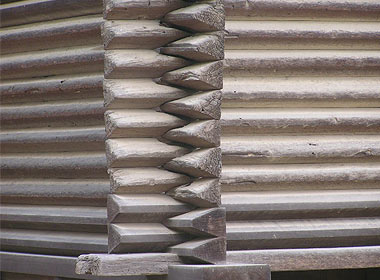|
||
 |
||

Toudaiji Hokkedou kyouko 東大寺法華堂経庫 (Nara)
(C)2001 Japanese Architecture and Art Net Users System. No reproduction or republication without written permission.
掲載のテキスト・写真・イラストなど、全てのコンテンツの無断複製・転載を禁じます。
|
||||||
| azegi 校木 | ||||||
| KEY WORD : architecture / general terms | ||||||
| Also pronounced azeki. Chamfered logs used to build walls for storehouses *azekura 校倉, in the ancient periods (8-12c). Azegi provided horizontal timbers, and could be round, hexagonal, square, or triangular in cross-section; triangular logs were the most common. The surface used for the interior wall was flat, but the other sides that appear on the exterior are slightly concave. Triangular beams could be hewn more easily than thick planks and were more resistant to weathering. Plank walls in storehouses, for example those in the center section, nakagura 中倉, of the *Shousouin 正倉院 at Toudaiji 東大寺 in Nara, have deteriorated to about half their original thickness. Azegi, however, have shown relatively little weathering except on their ends, where they extended outward at the corners. The amount of extension beyond the walls at the corners of the azegi logs increases as they are stacked up. | ||||||
 Toudaiji Hokkedou kyouko 東大寺法華堂経庫 (Nara)
|
||||||
| REFERENCES: | ||||||
| EXTERNAL LINKS: | ||||||
| NOTES: | ||||||
(C)2001 Japanese Architecture and Art Net Users System. No reproduction or republication without written permission. 掲載のテキスト・写真・イラストなど、全てのコンテンツの無断複製・転載を禁じます。 |
||||||